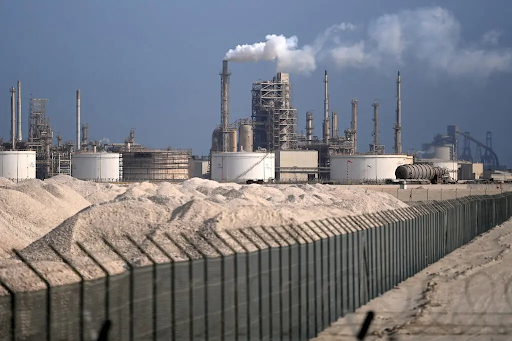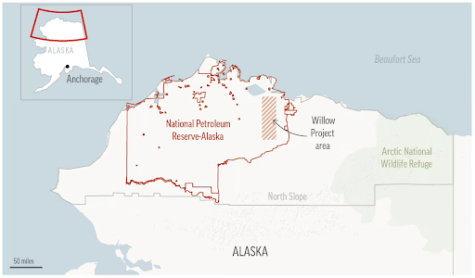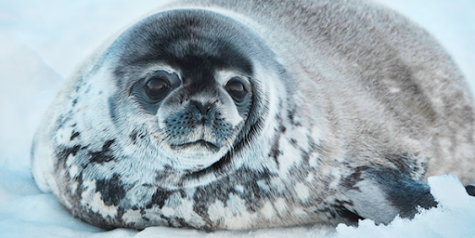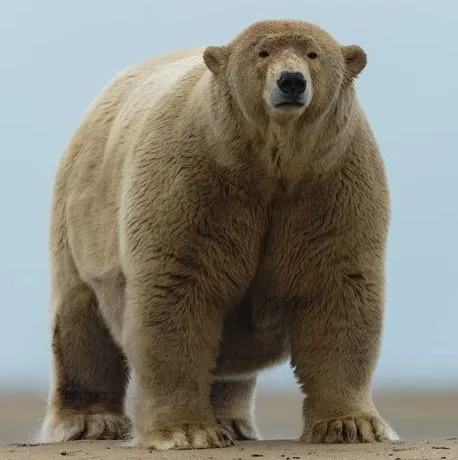The Willow Project

Photo Credit: New York Times Neil Hall/EPA, via Shutterstock
May 24, 2023
The Willow Project, recently approved by the Biden Administration on March 13, 2023, is sparking outrage in America and is predicted to have long-lasting and detrimental effects on all aspects of life and society.
The Willow Project will put anywhere from 239 to 287 metric tons of carbon dioxide into the atmosphere throughout its predicted 30-year run time. Carbon dioxide is one of the most dangerous greenhouse gasses that has a negative effect on the environment.
It is important to note that greenhouse gasses are vital for the survival of humans and other species as they keep the Earth’s climate habitable, but only to a certain extent. Nevertheless, greenhouse gases are now out of balance. These imbalances are not only threatening to environments around the globe but the species that live and thrive off of the habitats provided by nature as well.
Too many greenhouse gasses are known to cause a multitude of issues for the planet such as:

- Climate change as greenhouse gasses trap heat from the sun
- Contribute to respiratory disease from smog and air pollution
- Increase wildfires
- Cause extreme weather
- Interrupt food supply
How Will the Willow Project Affect Wildlife?
Since the project would put about 278 metric tons of greenhouse gas pollution into the atmosphere, the project will push vulnerable species closer to extinction.
However, pollution is not the only threat to the wildlife of the Arctic. The increase of land vehicles and sea vessels being brought into the area pose a risk for collisions between humans and animals, which puts both species at risk for injury and death.
Whales

Many different species of whales are going to be put at risk as a result of the Willow Project. More specifically, the endangered Bowhead whale and the North Pacific right whales. The Willow Project will directly impact the endangerment status of these whales. It is crucial to acknowledge this looming threat to these species that are already facing so much tragedy and danger they face daily.
The Bowhead Whale is most commonly impacted by the loss of food sources, climate change, vessel strikes, entanglement in fishing gear, ocean noise, offshore oil and gas development, pollution, and predation. All of these issues will occur more often due to the Willow Project.
These whales are some of the largest and rarest in the world. There are an estimated 30 left in the whole world. Similarly to the Bowhead Whale, these whales are most often impacted by climate change, which, as stated previously, will be one of the main outputs of the Willow Project.
Seals
Seal species like the Ringed and Bearded Seals, whose population numbers are already diminished as a result of climate change and habitat loss, are going to face much higher hazards and threats as a result of the Willow Project.

Once again, one of the main contributing factors to the increasing endangerment of Ringed Seals is climate change. The levels of Arctic sea ice have already plummeted a large amount, and, with the Willow Project approval, it will continue to decrease rapidly. Not only this, but the water temperature and acidity levels will increase, creating an even worse situation and habitat for not only Ringed seals but many species of seals.
The worsening situation for Ringed Seals will sequentially impact their’ predators, like Polar Bears, as well. Polar Bears hunt the seal pups, and with fewer pups, Polar Bears will be lacking their springtime prey. It is clear to say that the Willow Project will mess up the entire Arctic food chain once it fully begins.
Polar Bears

Moving forward with the Willow project will also put the endangered species of the Southern Beaufort Sea Polar Bear at risk. This specific species only has a population of roughly 900 animals.
The Willow Project will lead to the industrializing of thousands of acres that are habitat for many animals including the Southern Beaufort Sea Polar Bear. The species is already endangered due to rapid climate change, as it is predicted that polar bears will experience a 42 percent loss of their optimal summer habitat by the year 2050. Moving forward with the Willow project will only add to the list of problems threatening Polar Bears in the Arctic.
Alaskan Natives
The Willow Project will also have harmful effects on the Native tribes living in the area, as the drilling site would sit directly next to the land that the Iñupiaq community occupies. More specifically the land of the Nuiqsut Tribe and village.
Many residents of the village, which has a population of 542 people and is about 92.5% Alaskan Native, have strongly opposed the Willow Project as it will release deadly toxins that will directly impact residents and destroy the land that they depend on for hunting, fishing, and harvesting.
As a way to try to fight the proceeding of the project the environmental law group Earthjustice and law firm Trustees for Alaska filed lawsuits against the Interior Department and its top officials, the Bureau of Land Management, the US Fish and Wildlife Service, and other federal agencies.
However, on April 3rd, federal Judge Sharon Gleason of the US District Court of Alaska ruled in favor of the federal government and oil company ConocoPhillips which allows the project construction to continue as the court process unfolds. This ruling was made because the activities planned for the project in the coming months “do not include the extraction of any oil and gas.”
In Conclusion…
A statement made by the executive director of Sovereign Iñupiat for a Living Arctic (SILA), Siqiñiq Maupin, sums up the detrimental effects that the project will have. She said in an article published by Scientific American:“The Biden administration’s approval of the ConocoPhillips Willow project makes no sense for the health of the Arctic or the planet and comes after numerous calls by local communities for tribal consultation and real recognition of the impacts to land, water, animals, and people.”
Moving forward with the Willow Project is taking a step back in terms of helping the environment. Everyone should care about this issue as it is not simply just a matter of the climate but a matter of the fate of the world.
